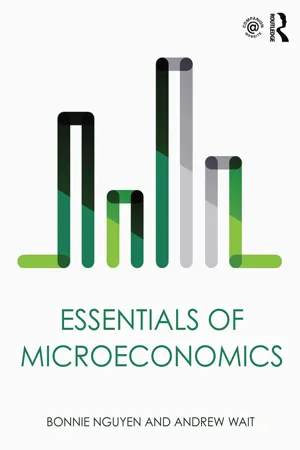Marketing
PED and YED
PED (Price Elasticity of Demand) measures the responsiveness of quantity demanded to a change in price. If PED is greater than 1, demand is considered elastic; if less than 1, demand is inelastic. YED (Income Elasticity of Demand) measures the responsiveness of quantity demanded to a change in income. A positive YED indicates a normal good, while a negative YED indicates an inferior good.
Written by Perlego with AI-assistance
7 Key excerpts on "PED and YED"
Learn about this page
Index pages curate the most relevant extracts from our library of academic textbooks. They’ve been created using an in-house natural language model (NLM), each adding context and meaning to key research topics.
- eBook - ePub
- Andrew Barkley, Paul W. Barkley(Authors)
- 2016(Publication Date)
- Routledge(Publisher)
Elasticities are unitless, and therefore attractive to social scientists who make comparisons among elasticities across all goods. The definition of price elasticity makes this clear:(9.7) Ed = (ΔQd /ΔP)*(P/Qd ).Since the price (P) and quantity demanded (Qd ) appear in the numerator and the denominator, the units of each cancel, leaving no units for an elasticity calculation. Hence, economists use elasticities rather than slopes to measure the responsiveness of consumer purchases to changes in prices and other economic variables. These unitless elasticities allow an unbiased comparison of the market responsiveness of apples and oranges.To summarize the discussion, elasticities measure how responsive consumers are to changes in price. An elastic demand curve shows that consumers are more responsive to price changes, while an inelastic demand curve reveals that consumers are not so likely to change their buying habits in response to price changes. The elasticities are comparable across all goods. The major determinant of the elasticity of demand is the availability of substitutes. If substitutes are available, then, when the price of a good increases, consumers switch to the lower-priced product.The price elasticity of demand explains many market-related situations. For example, gasoline stations in college towns often charge higher prices for gasoline the day before the beginning of Spring Break. On this day, when several thousand students are preparing to leave town, the demand for gasoline is relatively inelastic: many of the students will fill their cars’ tanks. Station owners know this and increase the price of fuel to take advantage of the fact that the students will pay higher prices in order to fulfill their vacation plans.Veterinarians often charge higher prices for rich people with poodles than for poor people with mixed breed mutts. Why? Because wealthier people are more likely to be willing and able to pay higher prices for vet services than poor people are. The elasticity of demand for medical services is lower (more inelastic) for rich persons than for poor. - eBook - ePub
Contemporary Economics
An Applications Approach
- Robert Carbaugh(Author)
- 2016(Publication Date)
- Routledge(Publisher)
This is because price and quantity demanded are inversely related according to the law of demand. In our example, the increase in ticket prices causes the numerator in the formula to be positive (+10 percent), while the decrease in game attendance causes the denominator to be negative (−5 percent). As a result, E d will have a negative value. By convention, economists drop the negative sign when calculating the price elasticity of demand, realizing that price and quantity demanded move in opposite directions. Depending on the response of buyers to a change in price, demand is characterized as elastic, inelastic, or unit elastic. Elastic. Demand is elastic when the percentage change in quantity demanded is greater than the percentage change in price, meaning that E d is greater than 1. Example: A 20-percent reduction in the price of Pepsi causes a 30-percent increase in the quantity demanded. Specifically, E d is 1.5 in this case (30 / 20 = 1.5). Inelastic. Demand is inelastic when the percentage change in quantity demanded is less than the percentage change in price, meaning that E d is less than 1. Example: A 30-percent increase in the price of Levi’s jeans causes a 10-percent decrease in quantity demanded. Specifically, E d is 0.33 in this case (10 / 30 = 0.33). Unit elastic. Demand is unit elastic when the percentage change in quantity demanded equals the percentage change in price, meaning that E d equals 1.0. Example: An 8-percent decrease in the price of Timex watches causes an 8-percent increase in the quantity demanded (8 / 8 = 1.0). Table 3.1 reports the estimated price elasticities of demand for selected products. When making such estimates, economists distinguish between a period during which consumers have little time to adjust (the short run) and periods during which consumers have time to fully adjust to a price change (the long run) - eBook - ePub
- Rob Dransfield(Author)
- 2013(Publication Date)
- Routledge(Publisher)
A restaurant owner who is considering increasing prices will first want to know what teffect this will have on the customers. Will there be no effect, a small fall in customers, or a large fall? If the number of customers remains the same or falls by a smaller percentage than the price change, the business will make more revenue. The calculation used to estimate this effect is price elasticity of demand, which measures how quantity demanded for a product responds to a change in its price. Anyone wishing to raise or lower prices should first estimate the price elasticity.Measuring price elasticity Key TermPrice elasticity of demand is calculated as follows:Price elasticity – where falls in price have a more than proportional effect on quantity demanded, quantity demanded is said to be elastic. If instead quantity demanded changes by a smaller proportion than the change in price, it is said to be inelastic.Table 3.9 illustrates different price elasticities. Price elasticity of demand is always a minus figure. This is because an increase in price (+) leads to a fall in quantity demanded (−). A fall in price (−) leads to a rise in quantity demanded (+). Another way of putting this is that there is an inverse relationship between price and quantity demanded.Table 3.9 Relative elasticitiesRelative elasticity Description Example Elastic demand Quantity demanded changes by a larger proportion than the change in price Price of a good rises by 5% while quantity demanded falls by 10% Elasticity = −2 Inelastic demand Quantity demanded changes by a smaller proportion than the change in price Price of a good rises by 5% while quantity demanded falls by 2.5% Elasticity = −1/2 Unitary elasticity of demand Quantity demanded changes by the same proportion as the change in price Price of a good rises by 5% while quantity demanded falls by 5% Elasticity = −1 If the demand for a good is inelastic, an increase in its price will lead to an increase in revenue to the seller. In contrast, where demand is elastic, an increase in a good’s price will lead to a fall in revenue to the seller. This is why producers of price inelastic goods do not engage in heavy discounting or get involved in price wars.How to make simple calculations- Calculate the percentage change in quantity demanded. This is the change in quantity demanded as a percentage of the quantity originally demanded (before the price change).
- Calculate the percentage change in price. This is the change in price as a percentage of the original price (before the price change).
- eBook - ePub
Essentials of Pricing Analytics
Tools and Implementation with Excel
- Erik Haugom(Author)
- 2020(Publication Date)
- Routledge(Publisher)
elastic (right panel) demand curves, as usually presented in microeconomic texts. In this case, price is a function of demanded quantity. Both ways of illustrating the price elasticity of demand induce the same conclusion, though. For a price change of a given magnitude, the change in demand will be (relatively) high if demand is elastic and (relatively) low if demand is inelastic.Figure 5.2 Illustration of inelastic (left panel) and elastic (right panel) demand. In the upper panel demand is used on the Y-axis (as commonly done in price–response functions). The lower panel illustrates inelastic and elastic demand with price on the Y-axis (as commonly done in the economics literature).We now understand that the price elasticity of demand is determined by the steepness of the price–response function. This statement is a little too general, though. The reason is that for most functional forms of price–response functions, the estimate of the price elasticity will depend on what part of the curve we choose to use to calculate an elasticity estimate. To see this, consider the following expression that can be used to estimate the price elasticity of demand:ε =(5.2)(/ dd)(− dp 2)(p 1)(p 1)(/)p 2−p 1p 1This measure is known as the point elasticity of demand , although it requires two combinations of prices and quantities. This estimate will depend on both the old price(and the new pricep 1)(, and where we are on the price–response function (the general level of demand at the two prices). An example is given below.p 2)Example 5.1: Calculation of price elasticity of demand for a specific product.A company increased the price of one of its products from $59 to $64. As a result, the sales went down from 12,000 units to 11,300 units. What is the point elasticity in this case? - eBook - ePub
- Tom Craig, David Campbell(Authors)
- 2012(Publication Date)
- Routledge(Publisher)
It is patently obvious that as our incomes vary, so does our demand for certain products. During our austere student years, we tend to make economies on such things as food and accommodation as a matter of necessity. Once we graduate and our incomes accordingly increase, we tend to increase our expenditures on these goods and many more besides (such as cars, holidays, etc.). There is clearly a link, then, between income and quantity demanded for some goods. We can analyse the nature of this demand in the same way that we did for prices by looking at the notion of income elasticity.The equation for calculating the coefficient of income elasticity (Ei) involves substituting price for income in the equations we have previously encountered:E i =orΔ q / qΔ y / yE i =or×Δ qΔ yy qE i =percentage change in quantity demanded percentage change in incomewhere Ei is the income elasticity of demand, Δy is the change in income, Δq is the change in quantity demanded resulting from the change in income, y is the income prior to the change and q is the quantity demanded prior to the change in income.The rules about the outcome for the coefficient and elasticity hold true for income elasticity:- Ei > is 1, we say that the product in question is income elastic.
- Ei < is 1, we say that the product in question is income inelastic.
- Ei equals exactly 1, we say that the product has a unitary income elasticity of demand.
The same product features apply to elasticity and inelasticity of income as for price. There are clearly some types of product that we must all buy regardless of income. These are necessities and have an income inelastic demand. Conversely, for some goods, our consumption will be more responsive to our income. These tend to be things we consider to be non-essential goods, for which, demand is income elastic. Although question 11 examines income elasticity for an individual, readers should be aware the economists usually examine this principle in the form of aggregate demand - eBook - ePub
Microeconomics
A Global Text
- Judy Whitehead(Author)
- 2014(Publication Date)
- Routledge(Publisher)
Hence the multiplicative relationship becomes additive when logs are taken. Moreover, the coefficients are elasticities. To show this, consider the price elasticity as an example:Differentiate the demand function (above) with respect toIt has been established in mathematics that the change in the log of a variable is proportionate to the change in the variable, then: and: In addition:Qx. This gives:whereηpis the price elasticity of demand for good x .The same holds for cross and income elasticities. b 2 is the cross elasticity of demand and b 3 is the income elasticity of demand.Demand models may also use real income (i.e. use a deflator) and relative prices. For example, the demand function may be expressed as:where P is a general price index.This assumes:- No money illusion
- Zero homogeneity
Through the use of data and econometric techniques, the demand function can be specified and the producer has immediate information on the nature of the demand curve and consequent marginal and average curves on which to plan production. This is of special use where the producer is entering a new market for the producer whether at the national, regional or global level.One caveat, however, is that some caution must be exercised in relation to empiricism as the data may show relationships that are purely statistical rather than real and hence may be providing false information. This may happen in the absence of any recourse made to theory, as indicated in Box 1.1 of Chapter 1 - eBook - ePub
- Bonnie Nguyen, Andrew Wait(Authors)
- 2015(Publication Date)
- Routledge(Publisher)
The concept of elasticity has several important applications in economics. We will discuss some of these now.10.3.1 Elasticity of demand
One of the most important applications is the elasticity of demand (Σd )3 It measures how sensitive the quantity demanded of a good (Qd ) is to changes in price (P). Specifically, it tells us the proportional change in quantity demanded of a good, given a 1 per cent change in its price. By substituting Qd and P into the formulas above, we can write down the midpoint (arc) method and the point method for calculating elasticity of demand:Midpoint methodPoint methodε d=⋅ΔQ dΔ PP mQ d mε d=⋅dQ dd PPQ dGiven the law of demand, the elasticity of demand will normally be negative (or at least non-positive).4 For this reason, some authors find it convenient to drop the minus sign when reporting the elasticity of demand, treating the negative sign as implicit. We will not adopt that convention here, but it should be noted that either approach is fine, so long as it is consistently applied.Now that we can calculate elasticity of demand, let us consider what our results mean:- If Σd = 0, demand is perfectly inelastic. For a 1 per cent change in price, there is no change in the quantity demanded; in other words, quantity demanded is not at all responsive to changes in price. In this special case, the demand curve is vertical, as shown in Figure 10.1 .Figure 10.1 When demand is perfectly inelastic, the demand curve is vertical (as seen the left panel). When demand is perfectly elastic, the demand curve is horizontal (as seen the right panel)
- If Σd < 0, demand is inelastic. For a 1 per cent change in price, the resulting change in quantity demanded is less than 1 per cent; in other words, quantity demanded is not very responsive to changes in price.
- If Σd = –1, demand is unit elastic. For a 1 per cent change in price, there is a 1 per cent change in quantity demanded; in other words, the quantity demanded changes by the same proportion as price.
- If Σd < –1, demand is elastic






